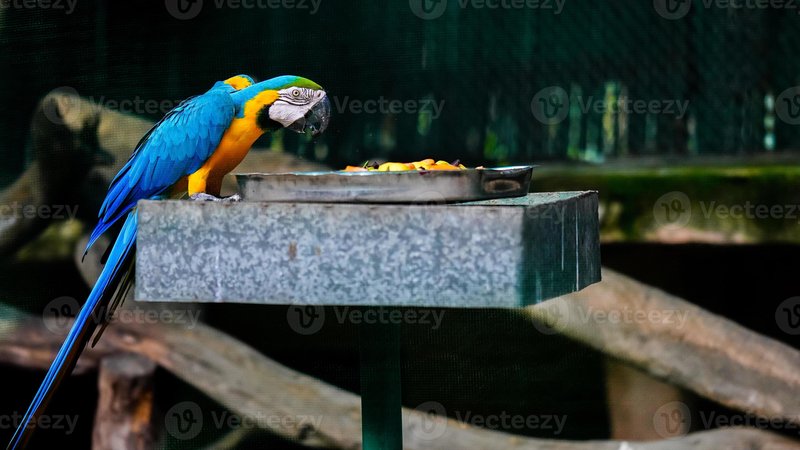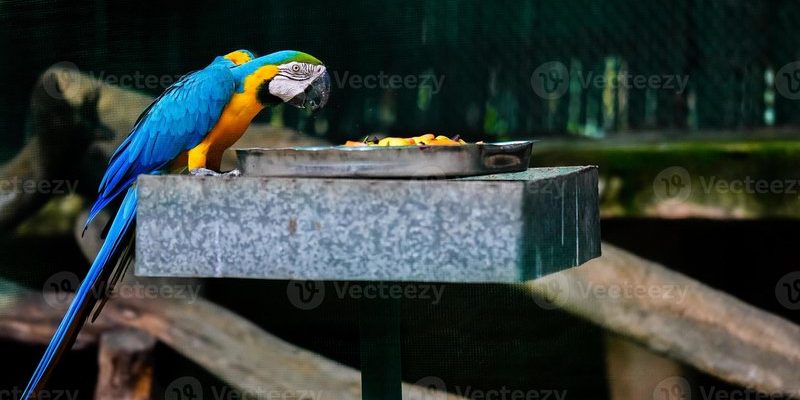
Imagine wandering through a lush rainforest filled with tall trees and vibrant plants. The blue-and-yellow macaw flits through the canopy, its bright feathers flashing against the green backdrop. This environment is not just their home; it’s also where they hunt or forage for food. Let’s dive into the world of the blue-and-yellow macaw’s diet and explore how they go about finding their meals.
The Diet of the Blue-And-Yellow Macaw
Blue-and-yellow macaws are primarily granivores, which means they mainly eat seeds. However, their diet is quite diverse and includes various fruits, nuts, and vegetables. In the wild, they feast on seeds from plants like palm trees and flowers. Their powerful beaks are specifically designed to crack open hard shells, making it easy for them to access the nutritious seeds inside.
In addition to seeds, these colorful birds also enjoy fruits like apples, mangoes, and berries. They are known to be quite resourceful, foraging in their environment for whatever is available. It’s like having a buffet right in the treetops—there’s always something new to try!
Interestingly, blue-and-yellow macaws also consume some flowers and leaves. This aspect of their diet is crucial, especially during certain seasons when seeds might be scarce. By being versatile eaters, they can adapt to changing environments, ensuring they have enough to sustain their energetic lifestyles.
Hunting and Foraging Techniques of Blue-And-Yellow Macaws
So, how do these birds find their food? The blue-and-yellow macaw hunts and forages in a few clever ways. They’re social creatures and often do this in pairs or small groups. This teamwork allows them to cover more ground and locate food sources more efficiently. It’s almost like having a buddy system, making their foraging adventures more successful!
These macaws have excellent eyesight, which helps them spot food from high in the trees. When they see a ripe fruit or a cluster of seeds, they swoop down to investigate. Their sharp beaks come into play here, allowing them to dig into hard-to-reach areas. Think of it as a bird version of treasure hunting, where they use their beaks to uncover hidden delights.
Another important aspect of their foraging behavior is their ability to remember where they’ve found food. This knack for navigation means they can return to particularly fruitful spots time and time again. Imagine knowing all the best places to get a tasty snack—you’d probably be pretty popular, right? That’s how macaws maintain a steady food supply in the wild.
The Role of Habitat in Their Diet
The blue-and-yellow macaw’s diet is significantly influenced by its habitat. These birds primarily reside in rainforests, woodlands, and savannas of Central and South America. In these lush environments, there’s an abundance of food options, from colorful fruits to nutrient-rich seeds. The specific plants in their habitat play a major role in their dietary preferences.
For instance, they rely heavily on palm nuts, which are a crucial food source. These nuts are not only high in calories but are also packed with essential nutrients that keep the macaws healthy and energetic. Sadly, habitat loss due to deforestation threatens these valuable food resources. As their homes shrink, these birds face challenges in finding enough to eat, highlighting the importance of conservation efforts.
Moreover, seasonal changes can affect the availability of food. During dry seasons, certain fruits may become scarce, forcing macaws to adapt their foraging strategies. This adaptability is vital for their survival and showcases their cleverness in overcoming obstacles in their natural environment.
Common Challenges in Foraging
For blue-and-yellow macaws, foraging isn’t always a walk in the park. They face various challenges while hunting for food. One major issue is competition with other animals, including other birds and mammals. These creatures are also on the lookout for tasty treats, which can make finding food a bit of a contest.
Additionally, exposure to natural predators presents another risk. While searching for food, macaws must be alert for hawks and other birds of prey. They often rely on their bright colors not just for communication but also as camouflage within the foliage, helping them avoid detection while they dine.
Weather conditions can also pose challenges. Heavy rain or storms can impact the availability of food, as it can wash away fruits or make it difficult for them to navigate their habitat. It’s a reminder that while these birds are beautiful and strong, they are still at the mercy of their environment.
How Human Activity Impacts Their Food Sources
The lifestyle of blue-and-yellow macaws is deeply intertwined with human activity. As we build more roads, homes, and farms, their habitats are increasingly threatened. Deforestation is a huge concern, as it reduces the number of trees and plants available for these birds to forage.
Moreover, agriculture can disrupt their food supply. For example, if areas where macaws typically find fruit and seeds are cleared for farming, it can lead to reduced food availability. This is not just a local issue; it affects the larger ecosystem as well, as macaws play an important role in seed dispersal that helps maintain forest health.
Conservation efforts are important in combating these challenges. By protecting their natural habitats and promoting sustainable practices, we can help ensure that blue-and-yellow macaws have access to the foods they need to thrive. It’s a reminder that our actions have a ripple effect in the natural world.
Fun Facts About Blue-And-Yellow Macaws’ Eating Habits
Here’s the thing: blue-and-yellow macaws are more than just gorgeous birds; they have some pretty interesting eating habits, too! For one, did you know that they can eat *up to 1 pound* of food a day? That’s quite a bit for a bird!
Another fun fact is that they often use their tongues to help them eat. Their tongues are quite strong and can manipulate food pieces, allowing them to get the most out of their meals. It’s like having a built-in fork and knife!
Finally, blue-and-yellow macaws have a unique social aspect to their eating habits. They often share food with their partners or young, reinforcing their bonds and strengthening social ties. It’s a lovely example of how even in the animal kingdom, sharing can promote friendship and unity.
Understanding what the blue-and-yellow macaw eats and how it hunts or forages not only helps us appreciate these magnificent creatures but also highlights the importance of protecting their habitats. From their diverse diet of seeds, fruits, and nuts to their clever foraging techniques, these birds showcase a remarkable adaptation to their environment.
As we learn more about their challenges and the impacts of human activities, it becomes clear that our responsibility extends beyond mere observation. By supporting conservation efforts and being mindful of our environmental footprint, we can help ensure that future generations will enjoy the beauty and grace of the blue-and-yellow macaw in the wild. So, the next time you think about these vibrant birds, remember the fascinating journey they take every day to find their meals, and how we can be part of their story.

